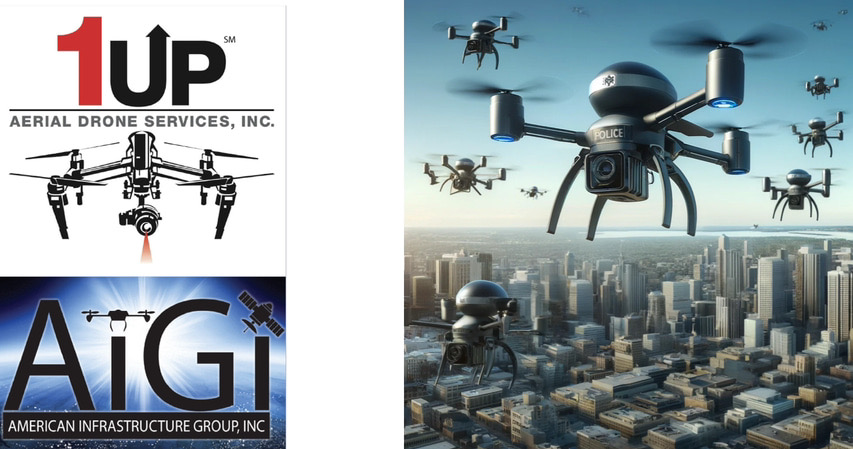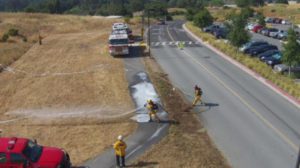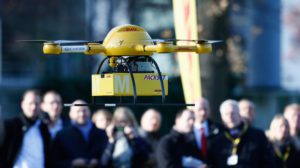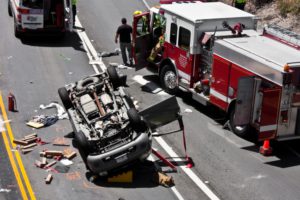Unveiling the Future:
Tactical Drone Swarms for Rapid Response in Law Enforcement
By Richard Armstrong – 1UP Drones Software Engineer – June 2024
This article explores embracing the cutting-edge technology of law enforcement with tactical drone swarms, paving the way for lightning-fast response times and unparalleled efficiency in critical situations. Explore how this innovative technology is shaping the future of public safety.

In the realm of law enforcement, every moment counts. Whether it’s responding to a critical incident, conducting search and rescue operations, or managing large-scale events, the ability to swiftly assess and address situations is paramount. In recent years, technological advancements have offered new tools to augment traditional methods of response, none more promising than tactical drone swarms.
The Emergence of Tactical Drone Swarms
Tactical drone swarms represent a paradigm shift in how law enforcement agencies approach rapid response scenarios. Traditionally, single drones have been deployed for reconnaissance or surveillance purposes. However, the limitations of single-unit operations, including restricted coverage area and limited battery life, have spurred the development of swarm technology.
Tactical drone swarms leverage the collective intelligence and capabilities of multiple drones operating in concert. These swarms are designed to autonomously coordinate their movements, communicate data in real-time, and adapt to dynamic environments with unprecedented agility. By distributing tasks among a networked swarm, agencies can achieve broader coverage, faster response times, and enhanced situational awareness.
Applications in Law Enforcement
The applications of tactical drone swarms in law enforcement are manifold, spanning various operational scenarios:
1. Emergency Response: During active shooter situations, hostage crises, or other high-risk incidents, time is of the essence. Tactical drone swarms can rapidly deploy to provide real-time intelligence to incident commanders, assess threats from multiple vantage points, and facilitate informed decision-making for tactical teams.
2. Search and Rescue: In scenarios involving missing persons or natural disasters, search and rescue efforts can be hampered by challenging terrain and limited visibility. Tactical Drone Swarms equipped with thermal imaging, LiDAR, and high-resolution cameras can cover expansive areas quickly, detect heat signatures, and identify survivors in remote or inaccessible locations.
3. Traffic Management: During large-scale events or traffic accidents, managing crowds and diverting traffic flow are critical tasks for law enforcement. Tactical drone swarms can provide aerial surveillance to monitor crowd movements, assess traffic patterns, and coordinate emergency response efforts with ground units in real-time.
4. Crime Scene Investigation: In forensic investigations, preserving the integrity of crime scenes and collecting evidence efficiently are paramount. Tactical drone swarms equipped with 3D mapping technology and multispectral imaging can reconstruct crime scenes with unparalleled accuracy, facilitating thorough investigations and supporting prosecutorial efforts.
Advancements in Swarm Technology
Recent research conducted by Oregon State University sheds light on the feasibility and efficacy of deploying Tactical drone swarms in operational environments. Through the Defense Advanced Research Project Agency’s OFFSET program, researchers demonstrated the capability of supervising swarms of over 100 autonomous ground and aerial robots with just one person, without subjecting them to undue workload.
According to Julie A. Adams of the OSU College of Engineering, the findings represent a significant step towards efficiently and economically using swarms in various roles, from wild-land firefighting to disaster response in urban environments. The research showed that a single human, termed the “swarm commander,” can oversee the coordinated movements and actions of a large number of drones through a virtual reality interface called I3.
Collaborators with Smart Information Flow Technologies developed this interface, allowing the commander to control the swarm with high-level directions, akin to a quarterback directing plays in football. The results of the study demonstrated that a single human can effectively deploy these systems in built environments, despite occasional workload spikes. [1]
Conclusion
Tactical drone swarms represent a transformative leap forward in law enforcement capabilities, offering unparalleled speed, versatility, and efficiency in critical situations. The integration of swarm technology into operational frameworks holds tremendous potential for improving public safety and protecting communities from emerging threats. As agencies adapt to meet evolving threats and challenges, the integration of swarm technology into operational frameworks will become increasingly indispensable.
At 1UP Drones, we are at the forefront of drone innovation, providing cutting-edge drone solutions tailored to the unique needs of law enforcement and first responder agencies. As agencies navigate the complexities of implementing the latest drone technology, it’s essential to stay informed about the latest advancements and best practices.
Contact 1UP Drones today to learn more about how we can help you revolutionize your agency’s rapid response capabilities and enhance public safety in your community. Together, let’s embrace and shape the future of law enforcement.
Visit our website at www.1updrones.com, email info@1updrones.com or give us a call at 972-808-5185. 1UP Drones – Elevating law enforcement and public safety, one flight at a time! 1UP Drones is a proud subsidiary of American Infrastructure Group, Inc. (AIGI).


